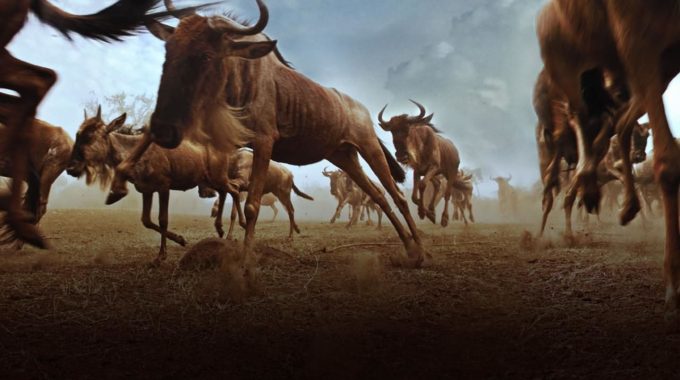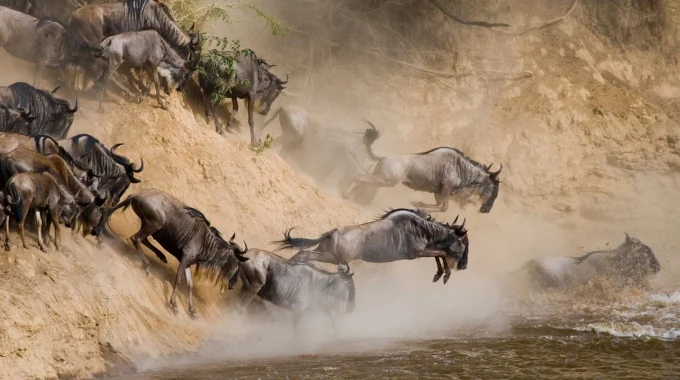How fast do wildebeest reproduce? - Wildebeests (Connochaetes spp.) are iconic members of the African savannas…
Where is the best place to see the Great Migration in Kenya?

Where is the best place to see the Great Migration in Kenya? – The Great Migration in Kenya is one of the most iconic wildlife events on the planet, and there are several key locations within the Maasai Mara National Reserve and surrounding areas that offer the best opportunities to witness this incredible spectacle. Here are the top places in Kenya to see the Great Migration:
1. Maasai Mara National Reserve
- Best Time to Visit: The peak of the Great Migration in the Maasai Mara usually occurs from July to October. This is when millions of wildebeest, zebra, and gazelles arrive in the Mara from the Serengeti, making their way across the Mara River and encountering predators like lions, crocodiles, and hyenas.
- Why It’s Great: The Maasai Mara is arguably the most famous destination to witness the Great Migration. During this time, you’ll have a chance to witness dramatic river crossings, where herds of wildebeest and zebra face the dangerous Mara River with its crocodiles and swift currents. The area also offers incredible predator action, including lion prides hunting the vulnerable animals.
- Where to Stay: Many accommodations are located in prime areas of the Mara, from budget campsites to luxurious lodges and exclusive tented camps. Staying in a location close to the Mara River increases your chances of seeing river crossings.
2. Mara Triangle (Western Maasai Mara)
- Best Time to Visit: July to October.
- Why It’s Great: The Mara Triangle is located in the western part of the Maasai Mara Reserve, and it’s one of the best places to see the Great Migration, especially the dramatic river crossings. The Mara Triangle has fewer visitors compared to the main reserve, providing a more exclusive safari experience. It’s also home to the famous Mara River crossings, where wildebeest must brave the river’s strong currents and crocodile-infested waters.
- Where to Stay: There are several luxury lodges and tented camps in the Mara Triangle, like Olonana Camp or Little Governors’ Camp, which offer excellent views of the migration and easy access to the river crossings.
3. Mara River (River Crossings)
- Best Time to Visit: Mid-July to September, with peak crossings typically occurring in August and September.
- Why It’s Great: The Mara River is the location for one of the most dramatic and dangerous parts of the migration—the river crossing. During this period, hundreds of thousands of wildebeest, along with zebras and gazelles, attempt to cross the river in search of grazing land. It’s a life-and-death struggle, with predators like crocodiles and lions waiting to ambush the herds as they cross. It’s a once-in-a-lifetime spectacle that attracts safari-goers from all over the world.
- Where to Stay: The area along the Mara River has a number of excellent lodges and camps, including Mara Serena Safari Lodge and Mara River Tented Camp, which provide easy access to the river and offer prime viewing of crossings.
4. Sand River and Keekorok (Southern Maasai Mara)
- Best Time to Visit: July to October.
- Why It’s Great: The Sand River area in the southern Mara is another hotspot for viewing the Great Migration. It’s here that many wildebeest cross as they enter the Maasai Mara from the Serengeti, usually from late July to August. The crossing is particularly exciting when the animals face off against the dangers of the river and predators in the area.
- Where to Stay: The Keekorok Lodge is located nearby and offers easy access to these crossings. It’s one of the oldest and most established lodges in the Maasai Mara, with great views and prime safari opportunities.
5. Naboisho Conservancy (Adjacent to the Maasai Mara)
- Best Time to Visit: The migration passes through this area during the peak months of July to September.
- Why It’s Great: Naboisho is a private conservancy located on the border of the Maasai Mara. Because it’s a conservancy, the area offers more intimate wildlife encounters, with fewer tourists than the main reserve. The conservancy provides a great opportunity to witness the migration without the crowds. You can also enjoy off-road driving, night safaris, and walking safaris, giving you a more exclusive experience. This area has plenty of resident wildlife and migratory herds during the peak migration months.
- Where to Stay: There are several luxury camps in Naboisho, such as Mara Naboisho Camp and Leopard Hill Camp, offering intimate and immersive safari experiences.
6. Olare Motorogi Conservancy (North of the Mara Reserve)
- Best Time to Visit: July to October.
- Why It’s Great: Olare Motorogi is a lesser-known conservancy that borders the Maasai Mara. It’s famous for its abundant wildlife and fewer tourists, providing a more peaceful experience. The conservancy is home to large migratory herds during the Great Migration, and you’ll often see big cats, especially lions, hunting the migrating herds. The private conservancy offers more flexibility in terms of safari activities and the chance to see the migration away from the crowds.
- Where to Stay: Exclusive camps such as Mara Plains Camp and Mahali Mzuri Camp offer luxury accommodations with easy access to the migratory herds.
Key Highlights of the Great Migration:
- River Crossings: The Mara River is the highlight of the migration, especially for its dramatic crossings.
- Predator Action: The migration brings predators like lions, cheetahs, and crocodiles, offering an excellent chance to see natural predator-prey interactions.
- Vast Herds: The migration sees over 1.5 million wildebeest and zebras moving in massive herds, with zebras providing a colorful contrast to the wildebeest.
- Aerial Views: Helicopter or hot air balloon safaris give you a unique bird’s-eye view of the migration.
When Is the Best Time to Go?
- The best time to witness the Great Migration is generally between July and October, with August and September being the peak months when river crossings are most dramatic.
- For those wanting to avoid the crowds, visiting in early July or late October can still offer great experiences with fewer tourists.
In summary, the Maasai Mara (especially near the Mara River) offers some of the best views of the Great Migration in Kenya, with several prime locations for seeing river crossings, predator-prey interactions, and vast herds of migrating animals. If you want to experience the migration in a more exclusive, tranquil setting, consider staying in one of the private conservancies, such as Naboisho or Olare Motorogi.



